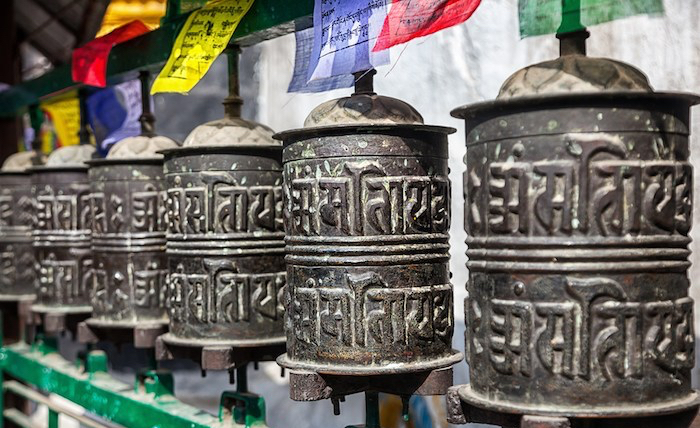A friend of mine is in the middle of a teacher training course at the moment, and he’s having a hard time memorising the Sanskrit names of the asanas – largely because he doesn’t see any point to them. From his perspective, English names are easier on him and easier on his students, so why are some yoga teachers still stuck on using Sanskrit?
I believe that when it’s done well, including Sanskrit in yoga classes is a powerful way to enrich your students’ understanding experience of yoga. Yoga is not just another form of exercise, but a spiritual practice with an incredibly long, rich history, and I see the use of Sanskrit as a nod to the history and the depth of the yoga tradition. It acts as a reminder that the postures we’re practicing don’t only serve to nourish our physical bodies, but also they’re part of a wider practice that nourishes our souls.
Sanskrit is thought to be one of the oldest languages on Earth. The word “Sanskrit” itself can be translated to the perfect, polished, or refined language. Today, Sanskrit is obsolete when it comes to day-to-day use, but it is still used for religious, philosophical and academic purposes.

It’s an incredibly rich language spiritually. For example, there are five different Sanskrit words for ‘love’, referring to physical attraction, true intimacy, loving kindness and friendship, devotion to a higher power, and self-love.
Incorporating Sanskrit in yoga classes can be a way to add depth and meaning to your teaching, as long as it’s done in a way that inspires curiosity and invites your students into a shared understanding, not in a manner that’s elitist and risks shutting people out.
Simply using Sanskrit (or Sanskrit and English) pose names is one simple way we can use Sanskrit in class, but there are others that will offer your students a deeper understanding of yoga philosophy.
Share the Story Behind an Asana
Many asana names come from Hindu mythology, and sharing the story behind the posture can be an engaging way to share some philosophy with your students.
For example, Hanumanasana refers to the monkey God Hanuman, who was a dear friend of the virtuous prince Rama. When Rama’s wife Sita was kidnapped by a 10-headed demon, Hanuman’s help was enlisted. Hanuman was called upon to leap across the water from India to Lanka. He was initially doubtful of his own ability, but then tunes in to his powers, enlarges his body and takes a giant ‘leap of faith’ across the ocean.
The story reminds us that we do have phenomenal abilities; we have talents that far outstrip our conceived limitations. It’s a lesson in opening our awareness in order to stand in our own power; in stepping outside of our comfort zone to achieve truly great things.
Theme Your Class Around a Sanskrit Word
Another way to incorporate Sanskrit into your classes would be to choose a meaningful Sanskrit word as the basis for a class theme.
Here’s are some beautiful Sanskrit words to get your ideas percolating:
Ananda: bliss or happiness.
Atma-prema: unconditional self-love.
Lila: divine play; the play of creation, destruction, and re-creation, the folding and unfolding of the cosmos. Lila emphasises the fact that the world is born in freedom and playful creativity, rather than necessity.
Maitri (Sanskrit version of Metta): loving kindness, unconditional friendship, goodwill.
Ojas: vitality, vigour. Located in the heart.
Prajna: insight, pure knowledge. The highest and purest form of wisdom, intelligence and understanding.
Prakriti: a primal creative or natural force; matter. The natural or original intended state of something or of an individual’s being. Feminine force, as opposed to Purusha.
Purusha: the cosmic self, consciousness, spirit. Masculine force, as opposed to Prakriti.
Rasa: juice, essence or taste. The essence of human experience; the emotions that govern human life.
Samsara: the ongoing cycle of birth and death, governed by karma
Samskara: the mental impressions or grooves left by our experiences and thoughts, (in this lifetime or a past lifetime).
Shanti: peace, calm.
Tejas: power, brilliance, energy or a name of the fire element. It also means effulgence (brightness taken to the extreme).
Include a Sanskrit Verse, Mantra or Prayer
Opening or closing your class by sharing a Sanskrit verse and its meaning is a simple, effective way to open your students’ awareness of the wider aspects of yoga. You could chant in call and response, or simply recite the mantra to your students and then explain it to them.
Here are just a few examples:
Lokah samastah sukhino bhavantu
May all beings everywhere be happy and free, and may the thoughts, words and actions of my own life contribute in some way to that freedom and happiness for all.
Aum Shanti, Shanti, Shanti
The repetition of ‘peace, peace, peace’ refers to peace of the body, mind and spirit.
Om Asato Maa Sad-Gamaya
Tamaso Maa Jyotir-Gamaya
Mrtyor-Maa Amrtam Gamaya
Om Shaantih Shaantih Shaantih
Keep me not in the unreality, but guide me towards reality
Keep me not in the darkness (of ignorance) but lead me towards the light.
Keep me not in the fear of death, but lead me towards immortality
Om, Peace, peace, peace.
References:
www.yogapedia.com
www.yogajournal.com






Leave A Comment